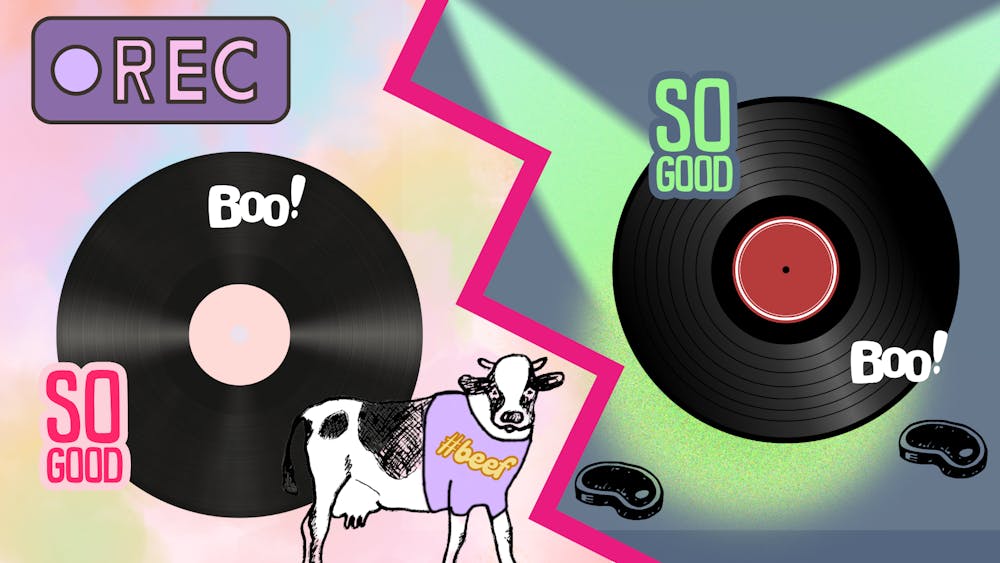Diss tracks are back in the spotlight with Taylor Swift’s latest album, where a song rumored to target pop icon Charli XCX has fans buzzing. But lyrical feuds and musical showdowns aren’t new. For decades, artists across genres—from hip-hop to pop—have channeled their drama, competition and personal conflicts into some of the most compelling music of their time. This isn’t just gossip; it’s a long-standing tradition of turning rivalry into art.
Swift’s latest song, “Actually Romantic,” isn’t just another pop confession—it’s a lyrical dagger.
Some fans speculate the song is a jab at Charli XCX. It feels like a return to the drama and rivalry that make pop music thrilling. This drama has accumulated and been brought forth as of recent, most notably in Swift’s twelfth studio album “The Life of a Showgirl” on “Actually Romantic.”
“I heard you call me '"Boring Barbie'" when the coke's got you brave,” Swift sings. “High-fived my ex and then you said you're glad he ghosted me. Wrote me a song saying it makes you sick to see my face.”
This is pop music at its most theatrical, and honestly, that’s what makes it great. Swift and Charli aren’t just writing songs–they’re building worlds, using rivalry as creative fuel. The drama isn’t a distraction, but it’s part of the storytelling.
Swift and Charli’s alleged feud is a masterclass in how rivalry fuels creativity, turning personal grudges into art.
The “beef” between the two pop powerhouses has been brewing for over a year. Charli’s song “Sympathy is a Knife” includes the line, “Don’t want to see you backstage at my boyfriend’s show, fingers crossed behind my back I hope they break up quick.”
This lyric felt like a pointed jab at Swift after her brief romance with the pop-rock band, “The 1975’s” frontman Matty Healy, who is now engaged to Charli’s friend, Gabriette Bechtel. Charli is connected to Healy because she is married to his drummer bandmate, George Daniel.
In June of 2024, fans of Charli were shouting “Taylor Swift is dead” at her gigs and online, though Charli shut down that behavior.
However, Charli then posed with a severed hand draped in friendship bracelets in New York Magazine in August, the imagery fueling speculation. To non-fans, it didn’t seem significant. Yet, to Swifties (fans of Swift), it was seen as a diss, as the bracelets became a symbol of The Eras Tour, Swift’s most recent tour.
Too often, fans expect pop stars to stay polite and bland, but diss tracks prove that conflict isn’t just inevitable–it’s necessary.
Swift also isn’t new to the art of the lyrical duel. Her 2017 album “Reputation” was practically built on it—a moody, defiant response to public scandal and rumored jabs at rivals like Kanye West and Kim Kardashian. That era proved she could turn personal backlash into pop mythology, using conflict as creative currency.
However, “Reputation” isn’t the only album with rumored digs at the duo. “thanK you aIMee,” a track on “The Tortured Poet’s Department: The Anthology,” though not exactly a diss track, is a song that thanks them for the publicity they have given her.
“Actually Romantic” feels like a continuation of that legacy.
Fans who demand politeness from pop stars miss the point that tension sells truth. These tracks are meant to be dissected, debated, and decoded. That is the true art of a diss track.
Big Three vs. Big Me
Pop isn’t the only genre thriving off friendly fire, though. Hip-hop has been doing it best for decades. Look no further than last year’s cultural earthquake: Kendrick Lamar versus Drake.
This wasn’t just a rap battle. It was a months-long masterclass in competition, artistry, and audacity. What started as mutual respect between two collaborators—Lamar on Drake’s “Buried Alive Interlude” in 2011, and Drake on Lamar’s “Poetic Justice”—turned into one of the most gripping rivalries in modern music.
The spark was Drake’s “First Person Shooter” in 2023, where J. Cole grouped himself, Drake, and Lamar as the “big three.”
However, Lamar disagreed, and he let the world know that with his line on “Like That,”: “...it’s just big me.” That lyric reignited a fire hip-hop hadn’t seen in years.
What followed was art disguised as warfare. Personal shots were flying—Drake’s “Family Matters” questioned Lamar’s fatherhood, and Lamar fired back with “Meet the Grahams,” apologizing to Drake’s children for having him as their father. It was uncomfortable, raw, and utterly riveting.
Then came “Not Like Us.” The song dominated streaming charts, radio, and playlists, a track so infectious it became an anthem and a weapon at once. The accusations by Lamar even prompted Drake to file a defamation lawsuit in January of this year, though it was dismissed this month. The feud blurred the line between art and real life—and that’s exactly what made it so fascinating.
This feud didn’t hurt hip-hop; it electrified it instead. Lamar walked away with five Grammys, a Super Bowl halftime show and reached over one billion streams on Spotify. More importantly, he reminded everyone what the genre is built on: competition, expression, and the courage to be unapologetically messy.
What made the Drake-Lamar feud so magnetic wasn’t just the insults, but the storytelling. Each artist built his own universe—Drake’s of wounded bravado and Kendrick’s of righteous fury–turning their clash into a study in identity and authenticity.
Of course, Lamar and Drake didn’t invent the art of lyrical warfare. They’re following a long tradition that shaped hip-hop itself.
Outlaw vs. King of New York
Tupac Shakur’s “Hit ‘Em Up” remains one of the most infamous diss tracks ever recorded – a searing attack on The Notorious B.I.G. and Sean Combs, as a response to Biggie’s song “Who Shot Ya?” The track intensified the East-West rivalry while thrilling the public during the 1990s.
These songs follow a friendship that soured after Tupac was robbed, with Tupac accusing Biggie and Combs of involvement in the attack.
“Call the cops when you see Tupac,” he sings in “Hit ‘Em Up.” “Who shot me? But ya punks didn't finish. Now ya 'bout to feel the wrath of a menace.”
It wasn’t just music, it was a cultural moment that reflected the tension, pride and danger surrounding two of rap’s biggest empires. The track intensified a feud that tragically mirrored the violence of the time – both rappers were killed by gunshot wounds within a year of its release – but it also cemented “Hit ‘Em Up” as the blueprint for how personal a diss track can be.
Queensbridge vs. Brooklyn
Then came Nas’s “Ether.” A song that redefined what a lyrical comeback could sound like. The beef had started back in 1996, with both exchanging diss tracks throughout their work.
Then, released in 2001 as a response to Jay-Z’s “Takeover,” Nas’s scathing lines called out Jay-Z’s ego and authenticity, flipping the power dynamic between two of hip-hop’s biggest names.
Jay-Z did not take “Ether” lightly, responding with two additional tracks: “People Talkin” and “Super Ugly.”
He later backtracked on the song after his mother called, telling him he had gone too far— specifically referring to his claim of an affair with Nas’s then-girlfriend.
The feud wasn’t just about two rappers trading bars. It was about who truly represented New York hip-hop in the post-Biggie era. It’s one of the rare diss tracks that permanently shifted hip-hop’s hierarchy.
Roxanne vs. Roxanne
Long before either, a 14-year-old girl, Roxanne Shante, proved that battle rap wasn’t just a man’s game. Her 1984 track “Roxanne’s Revenge” was a sharp, improvised response to UTFO’s “Roxanne, Roxanne,” which portrayed a woman as stuck-up for rejecting male advances.
“Tryin' to be like me, yeah, is very hard,” Shante sings. “You think you are God, but you do eat lard. Tryin' to be cute, and you're tryin' to be fly. Don't you know you wish you could be my guy?”
Shante flipped the script, defending herself and mocking the group in return. Her freestyle launched one of the first rap beefs ever – the “Roxanne Wars” – spawning over 30 response records from both male and female rappers.
UTFO was one of the respondents with their song “The Real Roxane,” which wound up becoming a hit. Others included Shante herself, Crush Groove and Dr. Fresh.
From Shante’s freestyle fire to Nas’s surgical precision, to Kendrick’s cultural reckoning and Swift’s pop re-inventions, diss tracks prove that conflict doesn’t corrupt art – it refines it. Whether over a beat or a synth line, artists use rivalry to define themselves. In doing so, they also define culture.
They challenge artists to dig deeper and fans to listen closer. According to Forbes, one of the most appealing aspects of diss tracks is that they push artists toward new creative paths and spark conversation about musical meaning, intent, and artistry.
Messiness isn’t a flaw—it’s the heartbeat of the art itself. It sparks creativity, fuels rivalry, and keeps pop culture from flatlining. Great art has never come from playing it safe. So if chaos keeps the music alive, then as Swift sings, “Baby, let the games begin.”
Kaelyn Blizard is the assistant editor of The Setonian’s News section. She can be reached at kaelyn.blizard@student.shu.edu.





